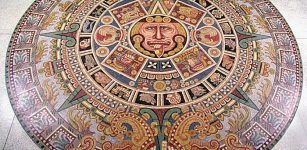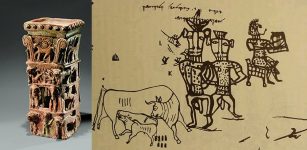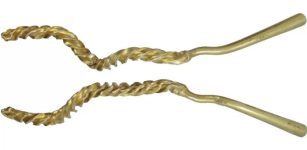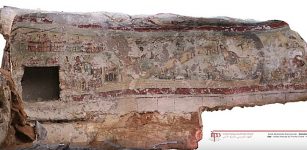The Red Dragon Of Wales – Ancient Symbol Dating Back To Roman Times
Conny Waters - AncientPages.com - The red dragon on the national flag of Wales is most often associated with the battle standard of King Arthur and other ancient Celtic leaders.
However, the Red Dragon of Wales dates back to Roman times. It was a Roman symbol cavalry units carried on their flags. The banners were used both to serve as markers on which the riders formed into different formations and to give orders using vigorous waving.
The Roman dragon was made of metal and had a head with an open mouth. The animal’s body was made of a tube of fabric, rather like a modern wind sock.
Following the fall of Rome, British princes continued to use Roman-style dracos as battle standards. The British military adopted many aspects of Roman military gear, including the red dragon.
The British army's last recorded use of the Draco was in about 1250, after which the red dragon of Wales began to be embroidered onto a flag as if it were a heraldic device. The green and white background, incidentally, comes from the family colors of the Tudor dynasty and was added in 1959.
Coat of arms of Henry VII, showing a Welsh Dragon as a supporter on the Royal arms of England. Credit: Wikipedia
Henry Tudor flew the red dragon of Cadwaladr ap Cadwallon as his banner, overlaid on a green and white field representing the Tudor House when he marched through Wales on his way to Bosworth Field. After the battle, the flag was carried in state to St. Paul's Cathedral to be blessed.
Updated on June 5, 2024
Written by Conny Waters - AncientPages.com Staff Writer
Copyright © AncientPages.com All rights reserved. This material may not be published, broadcast, rewritten or redistributed in whole or part without the express written permission of AncientPages.com
More From Ancient Pages
-
 Ancient Egyptian Women Had Equal Rights As Men – Egyptian Cosmology And Goddess Maat Reveal Why
Ancient History Facts | Dec 18, 2017
Ancient Egyptian Women Had Equal Rights As Men – Egyptian Cosmology And Goddess Maat Reveal Why
Ancient History Facts | Dec 18, 2017 -
 Aztecs’ Five Suns Creation Myth And Prophecy
Aztec Mythology | Jul 18, 2018
Aztecs’ Five Suns Creation Myth And Prophecy
Aztec Mythology | Jul 18, 2018 -
 The Golden Apple Myth And Norse Goddess Idun
Featured Stories | Jan 2, 2016
The Golden Apple Myth And Norse Goddess Idun
Featured Stories | Jan 2, 2016 -
 Ancient ‘Yahweh And His Asherah’ Inscriptions At Kuntillet ‘Ajrud Remain An Unsolved Biblical Mystery
Biblical Mysteries | Feb 12, 2021
Ancient ‘Yahweh And His Asherah’ Inscriptions At Kuntillet ‘Ajrud Remain An Unsolved Biblical Mystery
Biblical Mysteries | Feb 12, 2021 -
 On This Day In History: Battle of Englefield Was Fought – On Dec 31, 870
News | Dec 31, 2016
On This Day In History: Battle of Englefield Was Fought – On Dec 31, 870
News | Dec 31, 2016 -
 First Genome-Wide Ancient Human DNA From Sudan Shines New Light On Nile Valley Past
Archaeology | Dec 20, 2021
First Genome-Wide Ancient Human DNA From Sudan Shines New Light On Nile Valley Past
Archaeology | Dec 20, 2021 -
 3,000-Year-Old Twisted Gold Torc Discovered In Essex
Archaeology | Jul 15, 2023
3,000-Year-Old Twisted Gold Torc Discovered In Essex
Archaeology | Jul 15, 2023 -
 Huge Maya Stucco Mask Unearthed At Ucanha Site In Yucatan
Archaeology | Feb 19, 2021
Huge Maya Stucco Mask Unearthed At Ucanha Site In Yucatan
Archaeology | Feb 19, 2021 -
 Radiocarbon Dating Method Needs Adjustments – Researchers Say
Archaeology | Apr 1, 2020
Radiocarbon Dating Method Needs Adjustments – Researchers Say
Archaeology | Apr 1, 2020 -
 Traces Of Advanced Beings Who Walked Earth Millions Of Years Ago: Controversial Ancient History Examined
Ancient Mysteries | Jun 20, 2018
Traces Of Advanced Beings Who Walked Earth Millions Of Years Ago: Controversial Ancient History Examined
Ancient Mysteries | Jun 20, 2018 -
 Does This Ancient Box Contain Buddha’s Cremated Remains?
Archaeology | Nov 15, 2017
Does This Ancient Box Contain Buddha’s Cremated Remains?
Archaeology | Nov 15, 2017 -
 Large Mammoth Tusk And Bones Buried For Thousands Of Years Found In North Dakota
News | Jan 8, 2024
Large Mammoth Tusk And Bones Buried For Thousands Of Years Found In North Dakota
News | Jan 8, 2024 -
 Face Of Queen Lady Cao Reconstructed – Unique Look At The First Known Female Ruler In Peru
Archaeology | Jul 10, 2017
Face Of Queen Lady Cao Reconstructed – Unique Look At The First Known Female Ruler In Peru
Archaeology | Jul 10, 2017 -
 Unexplained Encounters: Beings With Inhuman Eyes – A Darker Side Of Humanity Or Groundless Worries?
Featured Stories | Mar 2, 2025
Unexplained Encounters: Beings With Inhuman Eyes – A Darker Side Of Humanity Or Groundless Worries?
Featured Stories | Mar 2, 2025 -
 Evidence Of Advanced Military Robots In The Ancient World – Unknown High-Tech Examined
Ancient Mysteries | Jan 13, 2021
Evidence Of Advanced Military Robots In The Ancient World – Unknown High-Tech Examined
Ancient Mysteries | Jan 13, 2021 -
 Can Diseases Explain Why Neanderthals Suddenly Disappeared About 40,000 Years Ago?
Archaeology | Nov 9, 2019
Can Diseases Explain Why Neanderthals Suddenly Disappeared About 40,000 Years Ago?
Archaeology | Nov 9, 2019 -
 1,800-Year-Old Richly Painted Tomb Unearthed In Northern Jordan
Archaeology | Oct 1, 2018
1,800-Year-Old Richly Painted Tomb Unearthed In Northern Jordan
Archaeology | Oct 1, 2018 -
 Ancient Aqueduct System Discovered In Boroujerd, Lorestan
News | Sep 16, 2015
Ancient Aqueduct System Discovered In Boroujerd, Lorestan
News | Sep 16, 2015 -
 On This Day In History: The King James Bible Is Published For The First Time In London – On May 2, 1611
News | May 2, 2016
On This Day In History: The King James Bible Is Published For The First Time In London – On May 2, 1611
News | May 2, 2016 -
 Ancient Complex Of Elephanta Caves In India
Featured Stories | Dec 27, 2016
Ancient Complex Of Elephanta Caves In India
Featured Stories | Dec 27, 2016


